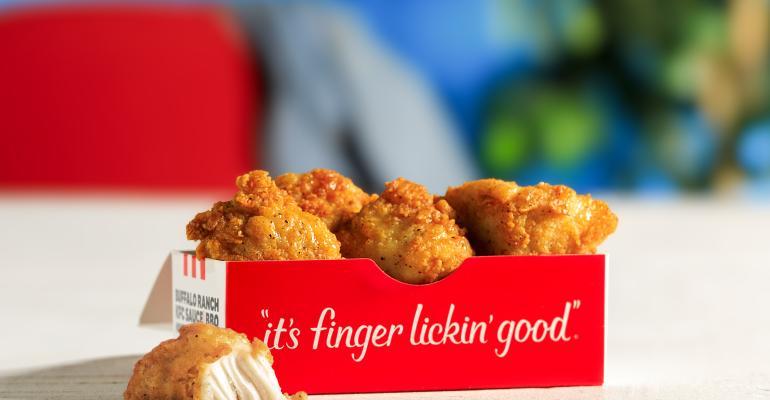Vijay Sukumar has been very busy lately.
KFC's chief food innovation officer has been charged with making his chain’s menu more relevant to younger consumers – no small feat for a 70-plus-year-old brand that earned its legacy through buckets filled with bone-in chicken. But he knows it’s a necessary task as consumer preferences change at an accelerated pace.
“Our focus is not only being relevant to core consumers, but also attracting new ones and that means going into formats that interest them,” he said during a recent interview at the KFC U.S. headquarters in Louisville, Ky. “Boneless is clearly a faster growing category that appeals to younger consumers.”
 And so in the past three years, KFC has introduced a swift cadence of boneless products, starting with its updated signature sandwich in 2021 that initially yielded more than twice the volumes of the brand’s previous chicken sandwich iterations. The sandwich was followed by new wraps, new nuggets, and chicken sandwich variations. Thus far, these sequential rollouts have done what they were intended to do; Sukumar said KFC is, indeed, gaining younger consumers.
And so in the past three years, KFC has introduced a swift cadence of boneless products, starting with its updated signature sandwich in 2021 that initially yielded more than twice the volumes of the brand’s previous chicken sandwich iterations. The sandwich was followed by new wraps, new nuggets, and chicken sandwich variations. Thus far, these sequential rollouts have done what they were intended to do; Sukumar said KFC is, indeed, gaining younger consumers.
“One of the best successes for us this year was the launch of our wraps. It was pushed as a transaction driver that provided value at an easy price point and that’s what it’s done,” he said.
That said, KFC’s innovation team isn’t just rolling out products based on consumer research favorability. The products must adhere to the brand’s standards, which makes things “extra hard,” according to Sukumar.
“My primary role falls into two buckets. One is to maintain the code, and make sure the products we sell are best in class and consistent,” he said. “Second, I also need to innovate and when you do that, you want to make sure you don’t lose the core DNA.”
For KFC, much of that core DNA comes from its Original Recipe – a blend of 11 herbs and spices that is so secret it requires three different suppliers, while the recipe itself is locked in a vault. Sukumar calls “the OG” KFC’s “crown jewel,” but it hasn’t been leveraged much for the brand’s recent innovations. Just the nuggets, launched in March, have featured the recipe. Perhaps not coincidentally, the chain sold over 100 million nuggets during the product’s first eight weeks on the menu.
KFC recently began testing new Original Recipe chicken tenders, which could bring the brand’s unique flavor to more products soon. Such differentiation is more critical than ever, as the competitive landscape of chicken intensifies from both legacy players and non-traditional players, like McDonald’s and Taco Bell, sharpening their focus on the popular protein. Sukumar doesn’t consider the growing competition to be a threat as much as an opportunity.
“If brands not traditionally known to be strong in the chicken space are coming into the chicken space, that must mean there’s something happening in the chicken space,” he said. “In my opinion, it’s driven by the consumer. They want more chicken. They want more fried chicken. I think that’s a great thing. It’s where we have an early advantage. We have a ton of experience and a key ingredient in our ‘OG’ to play with.”
He adds that consumers give the brand credit when it sticks to that core.
“We have to be authentically KFC and not just mimicking what everyone else is doing. Sometimes we feel pressure because the category is growing, but where we stay authentic is where we’ve had more success,” he said.
Sukumar also believes KFC has an advantage with its scale, which includes more than 25,000 restaurants in over 145 countries and territories around the world. This provides an ability to test across markets and adjust products for localized preferences. It also allows the company to share operational learnings for new menu introductions.
“I think the world is becoming a smaller place and we have a menu that’s common across our system, but we also engage in local innovation. There’s a multiplier effect,” he said.
The consumers are in the driver’s seat
As it turns out, the world becoming a smaller place has been the biggest driver for changing consumer preferences. Sukumar said younger demographics prefer spicy, globally-inspired flavors much more than their predecessors, for instance. They also like crunch and texture, which is why the Spicy Slaw Wrap, launched earlier this year, performed well.
“It was surprising for us on a wide acceptability basis. We know younger consumers don’t normally accept coleslaw as a side. But this product wasn’t about the coleslaw as much as it was about the heat and texture. When you marry good texture with a flavorful spicy sauce, that gives you a very different eating experience,” he said.
This lens is what is informing the KFC innovation team now as they contemplate spicy flavor profiles translating to products like mac and cheese, or anything that can work in a bowl or wrap. Sauces have become a bigger part of the strategy as well, as they’re a simple ingredient addition that creates variety, Sukumar said.
“If we can build meaningful variety without complicating operations, we’re paying a lot of attention to that,” he said. “We don’t want to play on every single flavor because it has to marry well with our core, but the idea is to establish platforms and keep innovating those platforms through flavors and textures because that’s what consumers want. We’re making food the hero now.”
Contact Alicia Kelso at [email protected]





